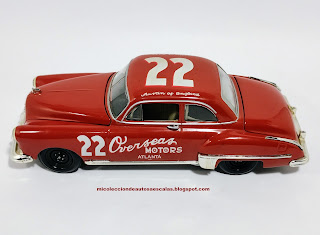Este es un blog de fotografías para la colección personal de autos de diferentes escalas.
Thursday, February 28, 2008
Action #22 Red Byron 1949 Overseas Motors Oldsmobile NASCAR NAPA 1:24 Diecast
Thursday, February 21, 2008
2000 Honda Civic SI Coupe 1:24
The Honda Civic Si is a sport compact trim of Honda's Civic. The Si (Sport Injected) trim was introduced for the third generation of Honda Civics in both Japan and North America. In Canada and elsewhere, the trim became known as the SiR for the sixth and seventh generations, and the Si trim was equivalent to the USDM EX model.
For the Japanese and European markets, the Civic Type R was adopted as the high-performance variant of the Civic, starting with the EK9 hatch for Japan in 1996 and then with the EP3 hatch for Europe in 2001. In North America the Type R name was never used until the 2017 model year with the launch of the Honda Civic Type R. Previous to this the Si label was the highest in North America (except for Acura vehicles). The Civic Si contrasts with the more track-oriented and spartan Type R, which has less sound deadening and amenities in return for better performance. The Civic Si has been positioned as more of a full-featured sport trim, featuring luxury options such as a sunroof and a seven speaker audio system.
Thursday, February 14, 2008
Inside Story Van Hot Wheels 1:64
From Fandom:
The Inside Story is a Hot Wheels Original Model designed to look like a van. Due to the huge glass window and sunroof, nothing gets in your view. A mid-mounted engine is located between the driver and the passenger. This makes sure that the back can be fully filled with a race car! That's right, this van is transporting a formula 1 styled race car. Because of the large window, the van is telling its "Inside Story".
This model has also been released under the name of Spider-Man Van, Silver Surfer and Beach Blaster.
Thursday, February 7, 2008
1957 Porsche 550A Spyder "1000 km race Buenos Aires 1958" Maisto 1:18
The Porsche 550 was a racing sports car produced by Porsche from 1953 to 1956. In that time only 90 Porsche 550s were produced, but it quickly established dominance in the 1.1- and 1.5- liter classes. The Porsche 550 is a mid-engine car with an air-cooled four-cylinder engine, following the precedent of the 1948 Porsche 356/1 prototype designed by Ferry Porsche. The mid-engine racing design was further developed with Porsche's 718 model; its advantages led to it becoming the dominant design for top-level racing cars by the mid-1960s.
The Porsche 550 has a solid racing history; the first race it entered, the Nurburgring Eifel Race in May 1953, it won. The 550 Spyder would usually finish top 3 in its class. Each Spyder was designed and customized to be raced.
A 1957 Porsche 550A Spyder sold at auction in 2018 by RM Sotheby's for $4,900,000 (£3,814,118) - the highest price for a 550 at auction.Monday, January 28, 2008
1979 Range Rover Safari Burago 1:25
The Land Rover Series I, II, and III (commonly referred to as series Land Rovers, to distinguish them from later models) are off-road vehicles produced by the British manufacturer Land Rover that were inspired by the US-built Willys Jeep. In 1992, Land Rover claimed that 70% of all the vehicles they had built were still in use.




















































